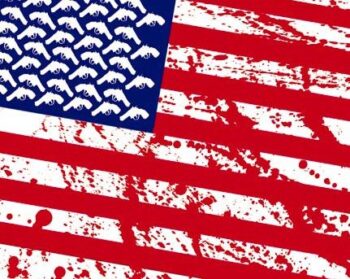
A gun is a mechanical device used to punch holes in people and other animals in order to kill them. I list humans first since “anti-personnel” weapons, as military firearms are euphemized by governments and the gun industry, comprise the bulk of worldwide production. From 1956 to 1986, China alone manufactured 10-15 million Type 56 assault rifles, their version of the Russian AK-47. Somewhere between seven and eight million M16 rifles have been made to date since the American military adopted it back in the early 1960s. By comparison, between 1936 and 1963, Winchester made approximately 600,000 Model 70s, an incredibly popular bolt-action rifle marketed to game hunters.
I cite the Model 70 as a counterexample to firearms strictly made for killing people. However, the rifle, considered one of the best-designed guns ever made, proved quite effective in dropping the most challenging quarry of all. The U.S. Marine Corps employed the M70 as its primary sniper rifle through the 1950s and 60s, most notably in Vietnam, where Gunnery Sergeant Carlos Hathcock became a legend by using it to amass 93 confirmed enemy kills. But after all, the first bolt-action rifles were designed for war, the nursery of all firearms innovations.
Having served as an infantry officer in the U.S. Army, I’ve fired thousands of rounds out of various pistols, rifles, and machine guns. I put together a list:
Colt M1911A1 .45 pistol
Beretta M9 9mm pistol
Browning 9mm hi-power pistol
Smith & Wesson .44 Magnum long-barrel pistol
Walther PPK .32 pistol
.22 rifle (various makes)
Springfield .30-06 bolt-action rifle
Colt M16A1 and A2 assault rifles
Kalashnikov AK-47 assault rifle
Uzi 9mm sub-machine gun
Fabrique National M249 SAW (Squad Automatic Weapon) light machine gun
M-60 medium machine gun
Browning M2 .50 caliber heavy machine gun
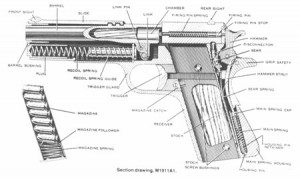 An infantry officer must be proficient with the weapons his soldiers use, as well as his own. Familiarity with the enemy’s weapons helps too. As a young lieutenant, I could disassemble and reassemble any weapon in minutes, fire it with reasonable accuracy, and recite by rote its effective range and specifications. Technical know-how will always win your soldiers’ confidence. It’s also vital to having any real sense of what your unit can do on the battlefield. If nothing else, being able to sling your M16 and work an M60 machine gun may also contribute to your personal survival.
An infantry officer must be proficient with the weapons his soldiers use, as well as his own. Familiarity with the enemy’s weapons helps too. As a young lieutenant, I could disassemble and reassemble any weapon in minutes, fire it with reasonable accuracy, and recite by rote its effective range and specifications. Technical know-how will always win your soldiers’ confidence. It’s also vital to having any real sense of what your unit can do on the battlefield. If nothing else, being able to sling your M16 and work an M60 machine gun may also contribute to your personal survival.
I did most of my shooting with M16 rifles, beginning with the A1 model which I fired in college ROTC. The M16 uses a 5.56mm bullet, a standard munition among NATO forces. But standardizing ammunition with America’s allies, while practical, was not what impelled the Army to choose the round. In the 1950s, ordnance experts pored over literally millions of combat accounts from both World Wars and concluded that the greatest factor in generating casualties was simply how many bullets went downrange. Killing the enemy boiled down to quantity, not quality. Their task: design a weapon that spewed lightweight rounds, making it possible for an infantryman to carry and shoot more ammunition.
The 5.56mm NATO bullet is essentially the same as an American .223 Remington round. Early on, critics scoffed, calling it nothing but a glorified .22 caliber. But what do these numbers mean? Well, take a brand-new No. 2 pencil and sharpen it. The shaved wooden cone is roughly the same size and shape as the projectile that comes whizzing out of an M16’s barrel at over 3,000 feet per second. It’s called a spitzer round (German for “pointy”) because of its aerodynamic shape, and it weighs 4 grams; a nickel weighs 5 grams.
It’s a small round. But at that velocity it inflicts devastating wounds. Larger bullets, such as the 7.62mm, which has twice the mass, will often poke clean holes through a body. But because of its relative light weight and spitzer design, the 5.56mm NATO round bounces around in the body, ripping up flesh and organs in its path. Po-faced ballistics experts describe this effect as the projectile’s tendency to yaw in soft tissue. The bullet often fragments on impact, greatly multiplying internal damage. Enthused by these findings, the Army has recently introduced an “improved” round with an extra gram of lead to burst into shrapnel when it hits home.
When I reported to the 25th Infantry Division in 1990, the Army had moved to the M16A2, which had better sights and a more accurate barrel. It also had a new selector switch with safety, semi-(automatic), and 3-round burst. Ordnance experts – perhaps the very same ones who advocated a sheer volume approach – had studied years of firefights since the original M16 debuted. They found that soldiers tended to flip the switch to “auto” and spray lead at the enemy. Naturally, most of these rounds never hit their intended targets. To increase accuracy and conserve ammunition, they removed the fully-automatic option, replacing it with a mechanism that dispenses three round-bursts with one pull of the trigger.
The Army’s penchant for acronyms applies to shooting. Every soldier learns BRAS, which stands for Breathe, Relax, Aim, Squeeze. It works. Looking downrange with the rifle stock pressed to your cheek, take a breath and exhale. By not breathing again until after you’ve fired, you prevent movement caused by your ribcage. Don’t squint your non-aiming eye yet, just get calm. Now peer through your sights, lining them up on the target. Gently, pull on the trigger. Don’t yank it, just slowly squeeze . . . bang! The report should almost surprise you. If it did, you’ve probably made an accurate shot.
The standard Army qualification range challenges the shooter with 40 pop-up targets arrayed from 50 to 300 meters. The targets stay exposed from three to seven seconds; the closer the target, the sooner it disappears. Shortening the time a soldier has to acquire a target makes up for the relative ease of hitting a silhouette at closer ranges. You shoot 20 rounds from a foxhole position, which allows you to rest the front part of the rifle on a sandbag, and 20 rounds on your belly, with nothing to brace the rifle but your shoulder, palms, and elbows. A soldier who hits 23-29 targets earns the “marksman” badge; 30-35 “sharpshooter”; and 36-40 “expert.” Each young private who graduates infantry basic training must at least qualify as a “marksman” – not surprisingly, the most generous standard with a seven-bullet spread.
I’ve always had better-than-average eyesight, which may explain why I always qualified “expert” with my M16. Through late grammar school, high school, and college, I was always shooting some kind of gun, whether it was during one of the countless BB-gun wars my friends and I waged in the woods or on trips to rifle and pistol ranges. Once I began ROTC, I received more formal marksmanship instruction.
When you hit a 300-meter target, there is a distinct pause between squeezing off the round and seeing the target drop. There’s also a keen sense of satisfaction; to put a lead cone the length and width of a pencil point through a man-sized silhouette over three football fields away gives you a sense of earned power, a measure of rugged competence that even the most primitive hunters must have felt. Anyone might wing a target close-up, but as the distance increases, tolerances become acute, the margin for error miniscule. Luck gets ruled out; it becomes a matter of skill.
Of course, almost all the killing done with firearms occurs at close range. In war, depending on terrain and vegetation, combatants typically fire at each other between 20 and 200 yards, unless it’s urban fighting, where firefights can rage between rooms. In 1970, the New York City Police Department implemented a reporting procedure for the detailed analysis of gunfights. In 1979, they took a retrospective look at all NYPD officer gunfight deaths going back to 1854. Of the 250 officers slain, 205 were killed within six feet of their assailants. The FBI conducted a similar study of law enforcement officers nationwide killed between 1991 and 2000. Half of the 601 officers were within five feet of their killers, 71% within ten.
Gun lobbyists are fond of the old cant, “guns don’t kill people, people kill people.” It is a specious argument. No one rails against the manufacture of axes or baseball bats. There are no campaigns to ban the sale of broadswords or Bowie knives. With a bolt-action rifle and a telescopic sight, I can put a bullet through my neighbor’s chest as he crosses in front of his living room window though his house is a hundred yards away. With a Glock 17 pistol stashed in my briefcase, I can walk into a boardroom, coolly dispatch a dozen executives, and still have five rounds left in the magazine to deal with security guards.
To put it another way, Jared Loughner doesn’t kill six people and wound another thirteen, including his intended victim, Congresswoman Gabrielle Giffords, if he brandishes a meat cleaver instead of a Glock 19 with a 33-round magazine. Virginia Tech doesn’t happen if Seung-Hui Cho heaves a cutlass in Norris Hall. Columbine never occurs if Eric Harris and Dylan Klebold enter their high school wielding Louisville Sluggers. Charles J. Whitman doesn’t kill 14 people and wound 31 others if he takes up his sniping position atop the 32-story tower at the University of Texas at Austin armed with a longbow and a quiver of arrows.
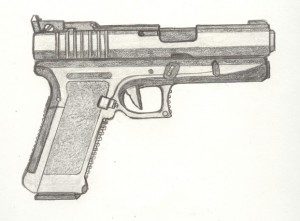 A gun’s power is arbitrary and wildly inordinate to its price, size, and ease of use. It bestows terrible sway – the ability to selectively kill at a distance or wipe out dozens close up – on any person holding it. Before the advent of firearms, becoming dangerous meant years of training, if not a lifetime’s upbringing in a warrior caste: the American Indian with tomahawk or bow and arrow; the medieval knight with sword and shield; the samurai with katana. Using his credit card, Seung-Hui Cho paid $571 for a Glock 19 pistol and a box of fifty 9mm bullets. At 30 ounces, a Glock 19 weighs slightly less than a quart of milk; it measures just under seven inches long. Its operation is simple: load, point, shoot fifteen times, reload. In nine minutes, Cho killed 30 people and wounded dozens more.
A gun’s power is arbitrary and wildly inordinate to its price, size, and ease of use. It bestows terrible sway – the ability to selectively kill at a distance or wipe out dozens close up – on any person holding it. Before the advent of firearms, becoming dangerous meant years of training, if not a lifetime’s upbringing in a warrior caste: the American Indian with tomahawk or bow and arrow; the medieval knight with sword and shield; the samurai with katana. Using his credit card, Seung-Hui Cho paid $571 for a Glock 19 pistol and a box of fifty 9mm bullets. At 30 ounces, a Glock 19 weighs slightly less than a quart of milk; it measures just under seven inches long. Its operation is simple: load, point, shoot fifteen times, reload. In nine minutes, Cho killed 30 people and wounded dozens more.
The phrase “the great equalizer” originally applied to the first revolvers, an innovation of Colt’s Patent Firearms Manufacturing Company. The slogan plays to a kind of David and Goliath sensibility. You picture a colossal brute leveled by a scrawny, Charlie Chaplin-like figure toting a silver Peacemaker. But of course, guns don’t make people equal, they make them unequal: they make them dead. And quite simply, it shouldn’t be so damned easy to kill another person.
***
When Barack Obama announced his candidacy for President, sales of pistols, rifles, and ammunition rose noticeably around America. In the days following his election, those sales soared. Gun store owners and their reactionary patrons dressed this ugly knee-jerk in political terms: they feared “overreaching legislation;” they perceived “a dangerous threat to their prerogatives;” and they worried that a liberal President would restrict what they believe is their right (often qualified with the phrase “God-given”) to own Berettas, Glocks, Uzis, and M16s.
An ominous euphemism heard repeatedly as justification for the purchase of an assault-rifle or high-capacity automatic pistol is that “it’s an insurance policy,” ostensibly against some imminent breakdown of society. For the last 230 years, the Constitution has proven a more than adequate insurance policy against all manner of catastrophe, foreign and domestic. But I can’t help thinking that anyone who buys a gun as an insurance policy secretly imagines themselves as Charlton Heston’s character in The Omega Man, Dr. Robert Neville, an Army colonel who battles murderous mutants in post-apocalyptic Los Angeles. Neville’s undoing comes when his sub-machine gun jams and he’s killed by a spear. Is there a message?
Gun sales also went up with Bill Clinton’s election. In pre-apocalyptic L.A. alone, his threat of a ban on assault rifles in 1994 did more to sell guns than the race riots that followed the Rodney King incident in 1992. But while there are always doomsdayers who re-stock their armories whenever a politician left of Attila the Hun gains office, you have to wonder how many of the recent “investors” were motivated by racism. It’s hard to imagine that these rabid consumers of AR-15s and AK-47s would demonstrate the same zeal (or at least justify their purchases the same way) if Al Gore or John Kerry had been elected President.
In the field of genetics, scientists speak of gene “expression” to refer to how inherited information in our DNA gets converted into working proteins in our bodies. DNA is a vast charter for the governance of our cells; how that sprawling code of conduct expresses itself is often a matter of interpretation. And where there is interpretation, there is error. Errors in genetic expression are called cancer.
America has a cancer, an interpretative error that originates in our government’s genetic code, the Constitution. The Second Amendment to the Constitution of the United States reads: “A well regulated Militia, being necessary to the security of a free State, the right of the people to keep and bear Arms, shall not be infringed.”
On June 26, 2008, the U.S. Supreme Court handed down an errant interpretation in the case of District of Columbia v. Heller, exacerbating the old misconception that the Second Amendment somehow grants individuals the right to own and use firearms. The Supreme Court boasts a fine history as America’s ultimate bulwark of justice, but it has, on occasion, been utterly mistaken. The court’s triumph in Brown v. Board of Education of Topeka, for example, doesn’t happen without first getting it horribly wrong in Plessy v. Ferguson.
Gun lobbyists fall back on the Second Amendment as the cornerstone of their supposed right to buy and own firearms. They recite the amendment’s second half as if it was an incantation, a spell that renders dumb all dissenters. But while the syntax of the amendment may be anachronistic, its meaning is clear. And the men who drafted the Constitution were not given to bombast or excessive verbiage.
As presented to the first session of the First Congress, the original text of what became the Second Amendment read: “The right of the people to keep and bear arms shall not be infringed; a well armed and well regulated militia being the best security of a free country; but no person religiously scrupulous of bearing arms shall be compelled to render military service in person.”
Clearly, the men who drafted the Constitution placed gun ownership solely in the context of organized military service. They wished to highlight the distinction between local and state militias as opposed to a federal army. State militias were seen as a safety measure against the possible use of a federal army to impose centralized tyranny.
The founding fathers eventually whittled down the amendment’s verbiage to the treacherous, 27-word version with which we contend today. Brevity, as Shakespeare wrote, is the soul of wit, but in legal realms it courts a sea of troubles.
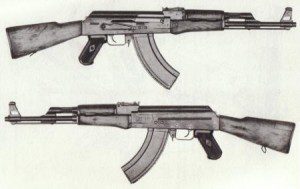 Still, if the Constitution’s authors had intended the Second Amendment to affirm individual rights to gun ownership, they would not have begun even the final edit with the phrase, “A well regulated Militia, being necessary to the security of a free State.” And clearly, a “militia” looking after “the security of a free state” is not the same as a private citizen strolling into Wal-Mart to purchase a 12-gauge shotgun and three boxes of ammunition. More importantly, it does not pertain to the paranoid fringe stocking up on assault rifles and high-capacity magazines in reaction to the peaceful election of an American President.
Still, if the Constitution’s authors had intended the Second Amendment to affirm individual rights to gun ownership, they would not have begun even the final edit with the phrase, “A well regulated Militia, being necessary to the security of a free State.” And clearly, a “militia” looking after “the security of a free state” is not the same as a private citizen strolling into Wal-Mart to purchase a 12-gauge shotgun and three boxes of ammunition. More importantly, it does not pertain to the paranoid fringe stocking up on assault rifles and high-capacity magazines in reaction to the peaceful election of an American President.
***
Behind the gun lobby’s smokescreen of red, white, and blue propaganda lies the heart of the matter: green. America didn’t become the world’s most heavily-armed nation by chance. Guns are big business. Even as the country recently reeled from recession–even as Detroit’s automakers, those iconic brands of American industry, faced bankruptcy, bailouts, or extinction–sales of guns and ammunition went up by more than 8%, based on federal data.
According to 10-K filings with the Securities and Exchange Commission, Remington Arms Company, the nation’s largest firearms manufacturer, had net sales of $591.1 million in 2008 (the most recent available filing.) In 2012, Smith & Wesson reported annual net sales of $411,997 million, up 20% (about $70 million) from fiscal 2011. Sturm, Ruger & Company, the fourth largest gunmaker in the U.S., saw over $328 million in total sales in 2011, pocketing $40 million in net income. Since 1990, Colt, America’s most famous gunmaker, has been a privately held company. In 1987, the last year that Colt held the Army’s contract to make M16s, the company posted $1.6 billion in total sales.
The Annual Firearms Manufacturing and Export Report prepared by the Bureau of Alcohol, Tobacco, Firearms and Explosives (BATFE) records the number of guns made in America each year by type and maker. (BATFE embargoes the data for one year, so 2010 is the most recent report available.) In 2010, American firms made 2,774,789 handguns, 1,825,774 rifles, and 743,362 shotguns. Of those, 105,327 handguns, 76,504 rifles, and 43,361 shotguns were exported; the rest remained for domestic sale and use.
To put these numbers in context, think of Busch Stadium, home to the St. Louis Cardinals. Last year, attendance averaged just over 42,000 per game; the Cardinals could have given every fan who entered the park a pistol, rifle, or shotgun for the entire season. Among the largest firearms producers, Smith & Wesson and Sturm, Ruger & Co. each made just over a half million handguns – enough to supply every current member of the U.S. Army and Marine Corps.
Unlike computers, televisions, or even automobiles, guns are simple machines that stick around for a long time. You’ll never find a rifle jutting out of anyone’s garbage can. A pistol might get intentionally chucked in a river by its nefarious owner, but it won’t end up on the scrap heap just because it’s old or broken. Even in the most innocent circumstances, a gun winds up wrapped in an old sock in a closet shoebox or stashed in an attic alongside a pair of ancient skis. Besides, you can’t simply throw out a shotgun even if you wanted to; you’d have to saw it into several pieces to render it inoperable. It’s not like leaving an outdated stereo by the curb.
As a citizen and former soldier, I acknowledge the grim necessity of firearms and their manufacture. Just as in the days of the Constitutional Convention, the security of a free nation requires a well-regulated military. But making firearms available to the military vastly differs from making them available to a public of over 300 million people. Consider the disparity of the vetting processes. In order for someone to get their hands on a rifle as a Marine, they have to join for several years and undergo thirteen weeks of a famously arduous boot camp. In Pennsylvania, a cursory felony check is all that stands between any 18 year-old and an AR-15 (the civilian version of an M16), unless, of course, the rifle is purchased at a gun show, where no background checks are required.
As public policy, the ease of obtaining firearms in this country represents a case of stunning negligence. You would think that politicians, especially those on the national stage, might literally be gun-shy. Four American Presidents have been assassinated, three with concealed pistols, the fourth, Kennedy, by rifle. Barack Obama is our 44th President, so 9% of American Presidents have been killed with guns. Ronald Reagan narrowly avoided being killed when a bullet fired by his would-be assassin, John Hinckley, Jr., missed his heart. An attempt on Harry Truman’s life in 1950 by two Puerto Rican nationalists armed with German automatic pistols (a Walther P38 and a Luger) resulted in the shooting deaths of White House Police Officer Leslie Coffelt and one of the assassins.
Between the manufacturers quietly pocketing profits in the background; their shills in Congress trying to legislate restrictions into oblivion; and strident gun-rights advocacy groups, most notably the the National Rifle Association, the industry’s Ministry of Propaganda; the gun lobby is a well-organized, well-moneyed, and well-entrenched camp. Their mandate, while flawed and misinterpreted, is, nevertheless, a Constitutional amendment.
What’s worse, the courts have often abetted the gun lobby’s reckless agenda. The Supreme Court’s disastrously wrongheaded decision in District of Columbia v. Heller is only a recent example. Thomas Delahanty, a Washington, D.C. police officer, was seriously wounded when David Hinckley attempted to assassinate Ronald Reagan. In 1989, Delahanty sued the manufacturer of Hinckley’s gun, the German company Röhm, which made what Americans would call Saturday night specials. In Delahanty v. Hinckley, the wounded officer’s lawyers made an incontrovertible argument: cheap, concealable pistols have only one real use: killing.
Nevertheless, the District of Columbia Court of Appeals ruled against such logic:
We reject application of the ‘abnormally dangerous activity’ doctrine to gun manufacture and sale. . . . The marketing of a handgun is not dangerous in and of itself, and when injury occurs, it is not the direct result of the sale itself, but rather the result of actions taken by a third party.
Despite its highfalutin tone, the court’s decision simply restates an old piece of gun lobby rhetoric: guns don’t kill people, people kill people.
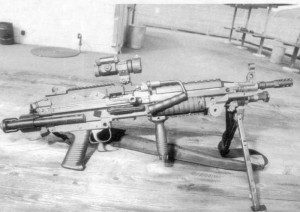 Still, the best chance to reverse the negligence of both the gun industry and our government resides in the courts. If I had suggested in 1993 that a series of class-action liability lawsuits would break the tobacco industry’s back, people would have said that I was smoking something other than Marlboros. Who could have imagined that seemingly invincible tobacco companies like Philip Morris and R. J. Reynolds would pay billions of dollars in settlements? And who could have imagined, by extension, that by the mid-2000s, every bar and restaurant in New York City would be smoke-free or that smoke-free policies would become standard in public spaces across the country?
Still, the best chance to reverse the negligence of both the gun industry and our government resides in the courts. If I had suggested in 1993 that a series of class-action liability lawsuits would break the tobacco industry’s back, people would have said that I was smoking something other than Marlboros. Who could have imagined that seemingly invincible tobacco companies like Philip Morris and R. J. Reynolds would pay billions of dollars in settlements? And who could have imagined, by extension, that by the mid-2000s, every bar and restaurant in New York City would be smoke-free or that smoke-free policies would become standard in public spaces across the country?
Many explanations have been offered for America’s peculiar and, quite simply, perverse relationship to guns. They usually involve a thesis based on the brutal realities of colonial life, the savagery of the frontier, and intermittent war. As proud as many Americans may be of our violent heritage, it is not unique. Compared to Europe’s upheavals of the last three centuries, America has enjoyed unusual peace and relative calm.
No, what makes America unique is its citizens’ long-standing tolerance for unparalleled levels of domestic gun violence. Sadly, there is an explanation for that phenomenon: human beings have an uncanny ability to grow accustomed to chaos and lunacy. Even if the drafters of the Constitution really intended the Second Amendment to grant private citizens the ability to own firearms, hasn’t the price of such a dubious freedom called into question the amendment’s relevance if not undermined its legitimacy outright? How many Columbines and Virginia Techs and Auroras, how many thousands of annual gun-deaths will it take before Americans decide to dismantle the gun industry and unseat its Congressional lackeys?
Grim statistics and senseless massacres seem incapable of changing the American public’s opinion about guns. Somehow the very essence of our relationship to firearms must change. Somehow, Americans, especially those exalted arbiters of justice in the Supreme Court, must realize what this former soldier has: a gun is a mechanical device used to punch holes in people and other animals in order to kill them.
***
Top Illustration by Mike Keefe, The Denver Post.




